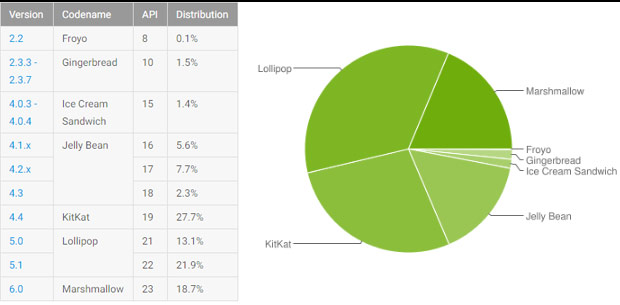Lollipop is positioned as the most widely used version of Android
Google has released statistics on the distribution of its Android platform updated to the month of September 2016 (September 5); eleventh month in which it appears the 6.x Marshmallow version, and the first month in which is available the most latest version of Android, 7.0 Nougat, although not as part of the charts because it has a share of less than 0.1 percent. The report keeps us updated on the progress of the new versions of the operating system (and setbacks of the old iterations) in terms of market share.
Let’s start with Marshmallow: there is a growth, progressive but still too slow to be able to think about the problem is solved. The 6.0 release reaches 18.7% of the overall share, an increase of 3.5% compared to the figure recorded at the beginning of August. Working backward, Lollipop stands at 35% (divided between the 13.1% of the 5.0 release of 5.1 and 21.9%), losing 0.5% compared to a few weeks ago. Behind is KitKat, which continues its descent until arriving at 27.7% (-1.5%), while Jelly Bean falls to 15.6% (-1.1%) dividing its share of the cake between the 4.1.x editions (5.6%), 4.2.x (7.7%) and 4.3 (2.3%).
This report finishes with Android Ice Cream Sandwich at 1.4% (-0.2%), Gingerbread 1.5% (-0.2%) and Froyo which nevertheless remains stoically and firmly anchored to its 0.1% (unchanged). Please remember that the statistics were obtained by analyzing the totality of the devices that have access to the Play Store platform, through the official application of Google, downloading games, applications and multimedia content, for a period of seven days ended Monday, September 5.

Android Nougat should increase further over the next few months, as they are expected on the market new smartphones and tablets powered by Android 7.0 out-of-the-box and also releases from the manufacturers of the first updates planned for their phones already sold. Continue, then, the growth of Marshmallow as new devices and updates are provided for those already existing on the market, while inevitably Android Lollipop will fall.
To find an effective solution to the problem of fragmentation, the initiatives so far fielded by Google have proved to be insufficient. It serves primarily for greater collaboration with OEM partners, aimed at making available official updates to new versions of the platform more quickly than is the case seen today.
